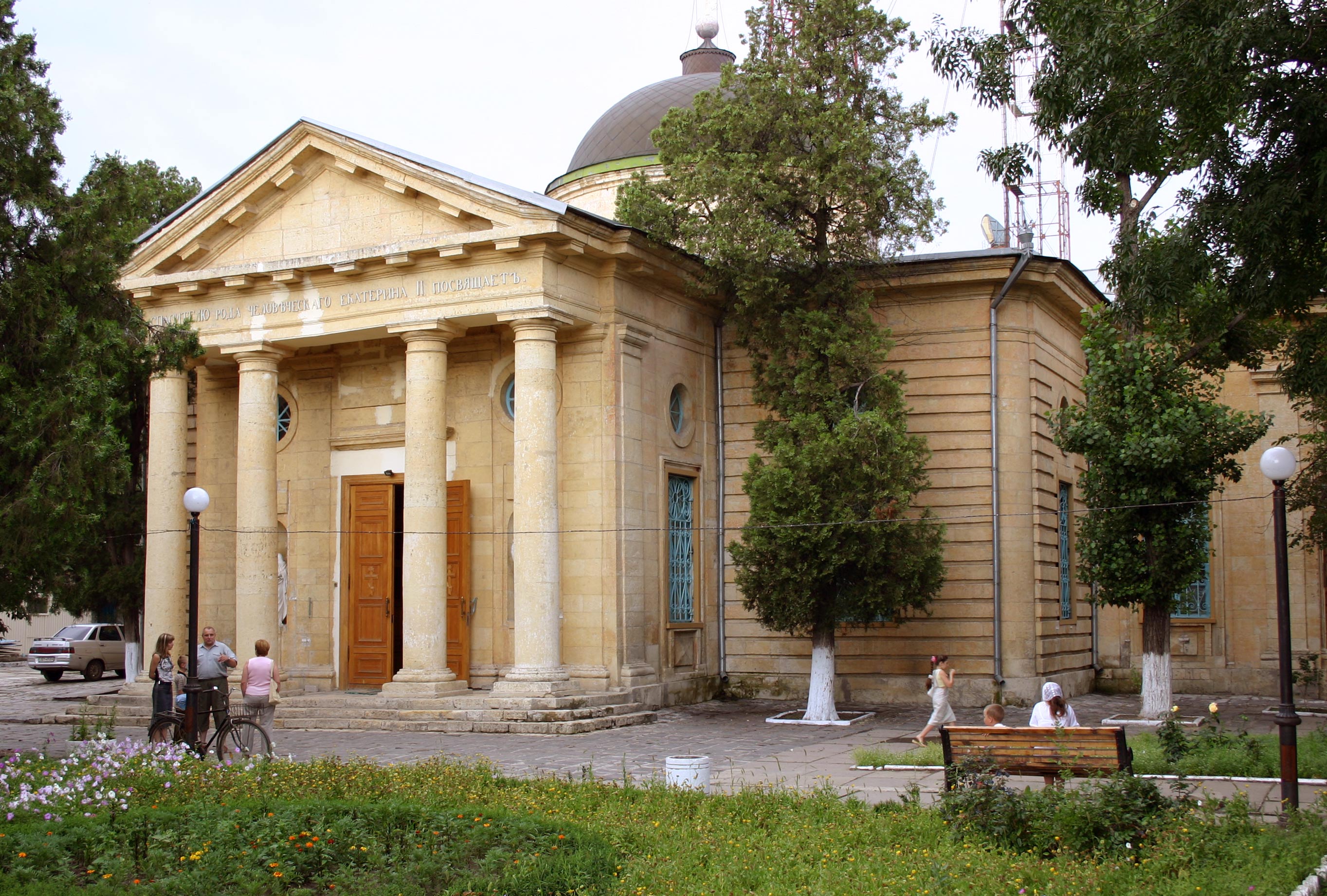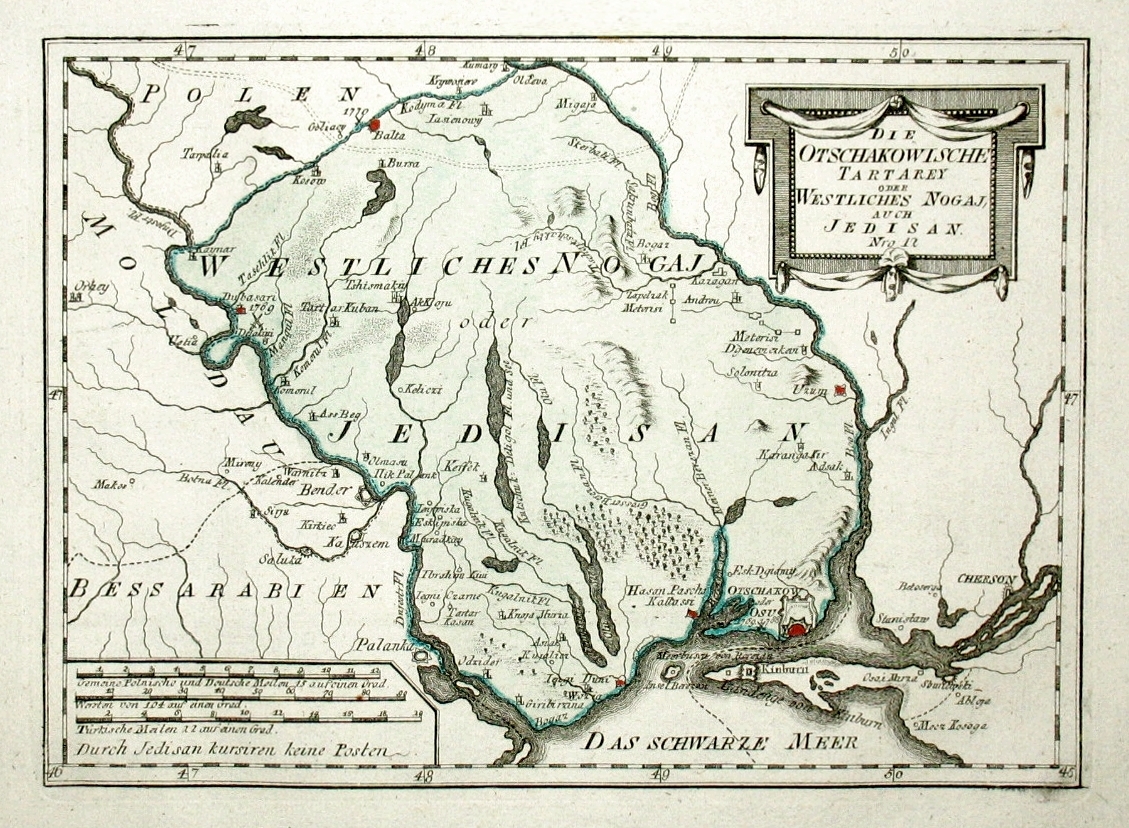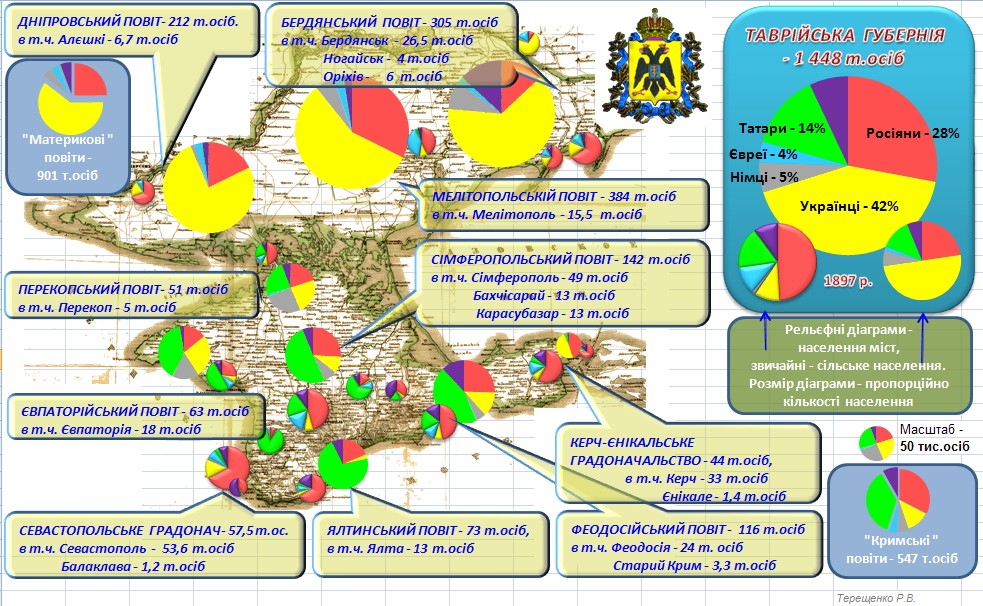|
Kherson Province
The Kherson Governorate (1802–1922; russian: Херсонская губерния, translit.: ''Khersonskaya guberniya''; uk, Херсонська губернія, translit=Khersonska huberniia), was an administrative territorial unit (also translated ''gubernia'', ''province'', or ''government''), of the Russian Empire located between the Dnieper and Dniester Rivers. It was one of three governorates created in 1802 when the Novorossiya guberniya was abolished. It was known as the Mykolaiv or Nikolayev Governorate () until 1803, when Nikolayev was separated into a special Nikolayev War Governorate as a center of the Black Sea Fleet and the governor seat was moved to Kherson. The economy of the governorate was mainly based on agriculture. During the grain harvest, thousands of agricultural laborers from the parts of the Empire found work in the area. The industrial part of the economy, consisting primarily of flour milling, distilling, metalworking industry, iron mining, ... [...More Info...] [...Related Items...] OR: [Wikipedia] [Google] [Baidu] |
Russian Empire
The Russian Empire was an empire and the final period of the Russian monarchy from 1721 to 1917, ruling across large parts of Eurasia. It succeeded the Tsardom of Russia following the Treaty of Nystad, which ended the Great Northern War. The rise of the Russian Empire coincided with the decline of neighbouring rival powers: the Swedish Empire, the Polish–Lithuanian Commonwealth, Qajar Iran, the Ottoman Empire, and Qing China. It also held colonies in North America between 1799 and 1867. Covering an area of approximately , it remains the third-largest empire in history, surpassed only by the British Empire and the Mongol Empire; it ruled over a population of 125.6 million people per the 1897 Russian census, which was the only census carried out during the entire imperial period. Owing to its geographic extent across three continents at its peak, it featured great ethnic, linguistic, religious, and economic diversity. From the 10th–17th centuries, the land ... [...More Info...] [...Related Items...] OR: [Wikipedia] [Google] [Baidu] |
Bessarabia Governorate
The Bessarabia Governorate (, ) was a part of the Russian Empire from 1812 to 1917. Initially known as Bessarabia Oblast (Бессарабская область, ''Bessarabskaya oblast'') as well as, following 1871, a governorate, it included the eastern part of the Principality of Moldavia along with the neighboring Ottoman-ruled territories annexed by Russia by the Treaty of Bucharest following the Russo-Turkish War (1806–1812). The Governorate was disbanded in 1917, with the establishment of Sfatul Țării, a national assembly which proclaimed the Moldavian Democratic Republic in December 1917. The latter united with Romania in April 1918. Around 65% of the territory of the former governorate now belongs to the Republic of Moldova (including the breakaway region of Transnistria); around 35% belongs to Ukraine. History Annexation As the Russian Empire noticed the weakening of the Ottoman Empire, it occupied the eastern half of the autonomous Principality of Moldavia, ... [...More Info...] [...Related Items...] OR: [Wikipedia] [Google] [Baidu] |
Ananyevsky Uyezd
Ananiv povit or Ananyev Uyezd (; ), located in modern-day Ukraine, was one of the subdivisions of the Kherson Governorate of the Russian Empire. It was situated in the southwestern part of the governorate. Its administrative centre was Ananiv (''Ananyev''). Demographics At the time of the Russian Empire Census of 1897, Ananyevsky Uyezd had a population of 265,762. Of these, 62.0% spoke Ukrainian, 13.5% Moldovan or Romanian, 11.0% Russian, 8.3% Yiddish, 3.8% German, 0.7% Polish, 0.2% Romani, 0.2% Bulgarian, 0.1% Czech, 0.1% Belarusian and 0.1% Greek Greek may refer to: Greece Anything of, from, or related to Greece, a country in Southern Europe: *Greeks, an ethnic group. *Greek language, a branch of the Indo-European language family. **Proto-Greek language, the assumed last common ancestor ... as their native language. References {{Reflist Uezds of Kherson Governorate Kherson Governorate ... [...More Info...] [...Related Items...] OR: [Wikipedia] [Google] [Baidu] |
Odessky Uyezd
The Odessa uezd (; ) was one of the subdivisions of the Kherson Governorate of the Russian Empire. It was situated in the southwestern part of the governorate. Its administrative centre was Odessa. Demographics At the time of the Russian Empire Census of 1897, Odessky Uyezd had a population of 610,042. Of these, 37.4% spoke Russian, 22.0% Yiddish, 21.9% Ukrainian, 10.3% German, 3.0% Polish, 1.4% Bulgarian, 1.2% Greek, 1.2% Moldovan or Romanian, 0.3% Belarusian, 0.2% Tatar, 0.2% Armenian, 0.2% French, 0.1% Italian, 0.1% Czech, 0.1% Latvian, 0.1% Lithuanian, 0.1% English English usually refers to: * English language * English people English may also refer to: Peoples, culture, and language * ''English'', an adjective for something of, from, or related to England ** English national ide ... and 0.1% Turkish as their native language. References {{Reflist Uezds of Kherson Governorate Kherson Governorate ... [...More Info...] [...Related Items...] OR: [Wikipedia] [Google] [Baidu] |
Odessa
Odesa (also spelled Odessa) is the third most populous city and municipality in Ukraine and a major seaport and transport hub located in the south-west of the country, on the northwestern shore of the Black Sea. The city is also the administrative centre of the Odesa Raion and Odesa Oblast, as well as a multiethnic cultural centre. As of January 2021 Odesa's population was approximately In classical antiquity a large Greek settlement existed at its location. The first chronicle mention of the Slavic settlement-port of Kotsiubijiv, which was part of the Grand Duchy of Lithuania, dates back to 1415, when a ship was sent from here to Constantinople by sea. After a period of Lithuanian Grand Duchy control, the port and its surroundings became part of the domain of the Ottomans in 1529, under the name Hacibey, and remained there until the empire's defeat in the Russo-Turkish War of 1792. In 1794, the modern city of Odesa was founded by a decree of the Russian empress Catherine t ... [...More Info...] [...Related Items...] OR: [Wikipedia] [Google] [Baidu] |
Yelisavetgradsky Uyezd as their native language.
Yelisavetgradsky Uyezd (''–ï–ª–∏—Å–∞–≤–µ—Ç–≥—Ä–∞–¥—Å–∫–∏–π —É–µ–∑–¥'') was one of the subdivisions of the Kherson Governorate of the Russian Empire. It was situated in the northern part of the governorate. Its administrative centre was Kropyvnytskyi (''Yelisavetgrad''). Demographics At the time of the Russian Empire Census of 1897, Yelisavetgradsky Uyezd had a population of 613,283. Of these, 66.1% spoke Ukrainian, 15.2% Russian, 9.4% Yiddish, 6.0% Moldovan or Romanian, 1.0% Belarusian, 0.9% German, 0.8% Bulgarian, 0.4% Polish, 0.1% Romani and 0.1% Tatar The Tatars ()Tatar in the Collins English Dictionary is an umbrella term for different References {{Reflist[...More Info...] [...Related Items...] OR: [Wikipedia] [Google] [Baidu] |
Tiraspolsky Uyezd as their native language.
The Tiraspol uezd (; ) was one of the subdivisions of the Kherson Governorate of the Russian Empire. It was situated in the southwestern part of the governorate. Its administrative centre was Tiraspol. Demographics At the time of the Russian Empire Census of 1897, Tiraspolsky Uyezd had a population of 240,145. Of these, 33.3% spoke Ukrainian, 24.9% Romanian, 16.9% Russian, 9.9% Yiddish, 9.8% German, 3.7% Bulgarian, 0.8% Polish, 0.2% Armenian, 0.1% Belarusian, 0.1% Romani and 0.1% Tatar The Tatars ()Tatar in the Collins English Dictionary is an umbrella term for different References {{Reflist[...More Info...] [...Related Items...] OR: [Wikipedia] [Google] [Baidu] |
Ovidiopol
Ovidiopol ( uk, Ові́діополь; russian: Овидиополь; tr, Hacıdere) is a coastal urban-type settlement in Odesa Oblast, Ukraine. It is located on the eastern bank of Dniester Estuary directly across Bilhorod-Dnistrovskyi and west of Odesa. Population: History The place is first mentioned as early as 17th century.Vermenych, Ya. Ovidiopol'. Encyclopedia of History of Ukraine. 2010 Hacıdere belonged to Akkerman sanjak of Silistra Eyalet, or Kefe Eyalet where Akkerman sanjak was actually located. At Medieval times Akkerman, at that time known as Maurocastrum, was a trade port of Byzantine and later Genoese colonies out of the Southern coast of Crimea. In mid 18th century Hacıdere was a big populated place with a pier through which was conducted a grain trade. During the 1768–1774 Russo-Turkish War, in 1769 Hacıdere was burned down by Zaporizhian Cossacks led by Petro Kalnyshevskyi. About twenty years later in 1789 (during the 1787–1792 Russo-Turkish ... [...More Info...] [...Related Items...] OR: [Wikipedia] [Google] [Baidu] |
Aleksandriysky Uyezd
The Aleksandriya uezd (; ) was one of the subdivisions of the Kherson Governorate of the Russian Empire. It was situated in the northeastern part of the governorate. Its administrative centre was Oleksandriia (''Aleksandriya''). Demographics At the time of the Russian Empire Census of 1897, Aleksandriysky Uyezd had a population of 416,576. Of these, 85.1% spoke Ukrainian, 9.4% Russian, 3.7% Yiddish, 0.7% Moldovan or Romanian, 0.6% Belarusian, 0.3% German and 0.2% Polish Polish may refer to: * Anything from or related to Poland, a country in Europe * Polish language * Poles Poles,, ; singular masculine: ''Polak'', singular feminine: ''Polka'' or Polish people, are a West Slavic nation and ethnic group, w ... as their native language. References {{Reflist Uezds of Kherson Governorate Kherson Governorate ... [...More Info...] [...Related Items...] OR: [Wikipedia] [Google] [Baidu] |
Khersonsky Uyezd
Khersonsky Uyezd (''–•–µ—Ä—Å–æ–Ω—Å–∫–∏–π —É–µ–∑–¥'') was one of the subdivisions of the Kherson Governorate of the Russian Empire. It was situated in the southeastern part of the governorate. Its administrative centre was Kherson. Demographics At the time of the Russian Empire Census of 1897, Khersonsky Uyezd had a population of 587,804. Of these, 55.1% spoke Ukrainian, 24.6% Russian, 11.9% Yiddish, 3.5% German, 2.1% Belarusian, 0.9% Polish, 0.8% Moldovan or Romanian, 0.6% Bulgarian, 0.2% Tatar, 0.1% Swedish and 0.1% Greek Greek may refer to: Greece Anything of, from, or related to Greece, a country in Southern Europe: *Greeks, an ethnic group. *Greek language, a branch of the Indo-European language family. **Proto-Greek language, the assumed last common ancestor ... as their native language. References {{Reflist Uezds of Kherson Governorate Kherson Governorate ... [...More Info...] [...Related Items...] OR: [Wikipedia] [Google] [Baidu] |
Uyezd
An uezd (also spelled uyezd; rus, —É–µÃÅ–∑–¥, p= äÀàjest), or povit in a Ukrainian context ( uk, –ø–æ–≤—ñ—Ç), or Kreis in Baltic-German context, was a type of administrative subdivision of the Grand Duchy of Moscow, the Russian Empire, and the early Russian SFSR, which was in use from the 13th century. For most of Russian history, uezds were a second-level administrative division. By sense, but not by etymology, ''uezd'' approximately corresponds to the English "county". General description Originally describing groups of several volosts, they formed around the most important cities. Uezds were ruled by the appointees ('' namestniki'') of a knyaz and, starting from the 17th century, by voyevodas. In 1708, an administrative reform was carried out by Peter the Great, dividing Russia into governorates. The subdivision into uyezds was abolished at that time but was reinstated in 1727, as a result of Catherine I's administrative reform. By the Soviet administrative reform of 1923 ... [...More Info...] [...Related Items...] OR: [Wikipedia] [Google] [Baidu] |
Taurida Governorate
The Taurida Governorate (russian: Тавріическая губернія, modern spelling , ; crh, script=Latn, Tavrida guberniyası, ) or the Government of Taurida, was a historical governorate of the Russian Empire. It included the Crimean Peninsula and the mainland between the lower Dnieper River and the coasts of the Black Sea and Sea of Azov. It was formed after the Taurida Oblast was abolished in 1802 in the course of Paul I's administrative reform of the southwestern territories that had been annexed from the Crimean Khanate. The governorate's centre was the city of Simferopol. The province was named after the ancient Greek name of Crimea - Taurida. Today the territory of the governorate is part of the Crimea, Kherson, and Zaporizhzhia regions of Ukraine. Administrative divisions The governorate comprised three counties (uyezds) on the mainland: * Berdyansky Uyezd, centred in Berdyansk * Dneprovsky Uyezd, Oleshky * Melitopolsky Uyezd, Melitopol and five counties pl ... [...More Info...] [...Related Items...] OR: [Wikipedia] [Google] [Baidu] |




